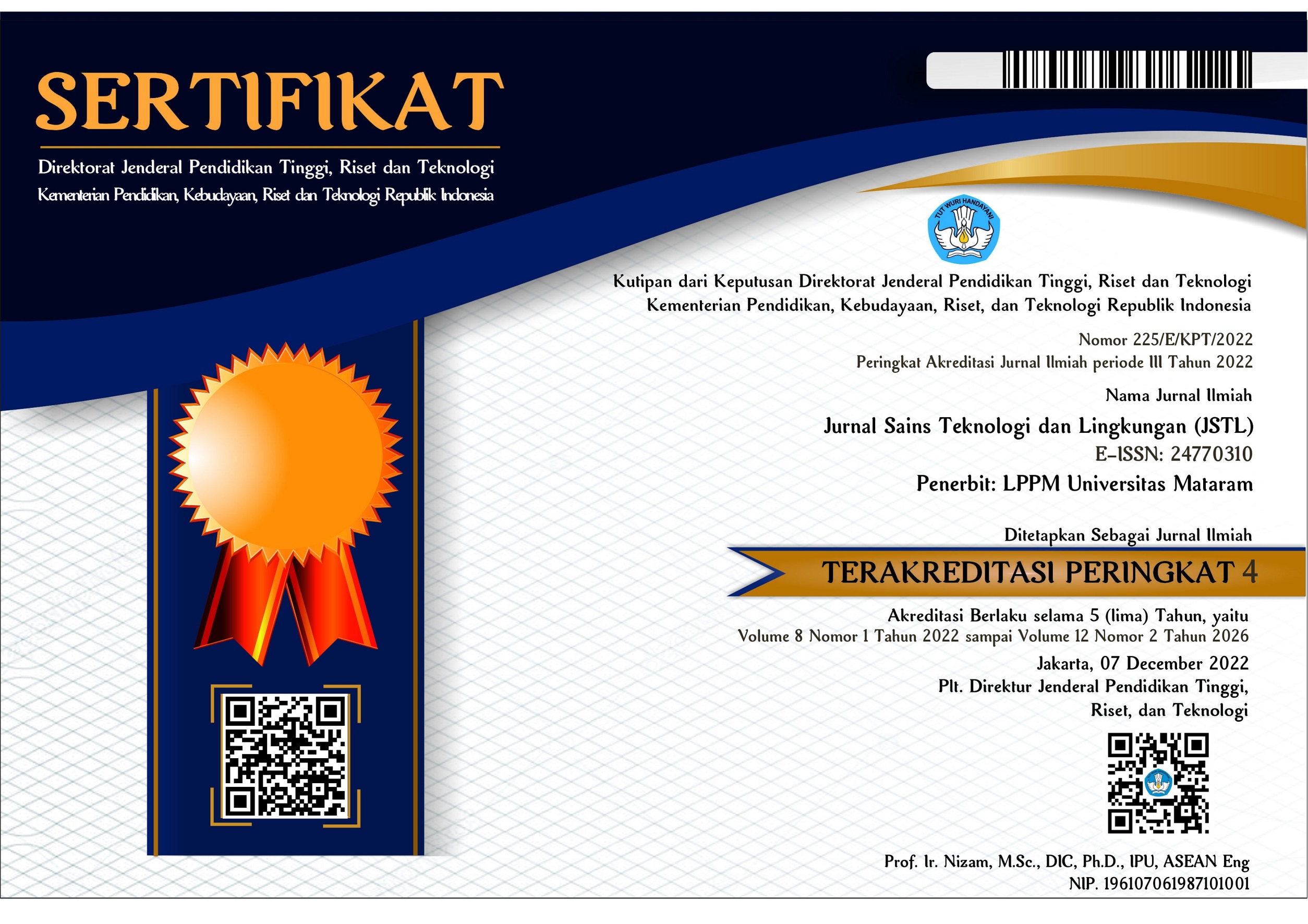Status Terkini Tutupan Terumbu Karang di Perairan Dangkal Pulau Bedil, Desa Labuan Bajo, Kabupaten Sumbawa, NTB
DOI:
https://doi.org/10.29303/jstl.v0i0.277Keywords:
coral reef, line intercept transect, percent cover, coral mortality indexAbstract
Bedil Island is included in the Keramat, Bedil, and Temudong Small Island Park (TPK), which was approved by the Regent of Sumbawa. Administratively, this island is included in the Labuan Bajo Village area, Sumbawa, NTB. There is the existence of coral reef ecosystems in these waters that form a reef flat and reef slope profile, that stretches to the southwest and northeast. By its designation as a small island park, the coral reefs in Bedil Island are used as an underwater tourism object. This study aims to determine the current condition of coral reef cover in the waters around Bedil Island, especially in the eastern and southern parts of the island. Coral reefs in the north and west area are limited and there is the existence of seagrass beds. The line intercept transect method is carried out by spreading the roll meter as far as 50 meters on the east and south sides of the island with a depth of 2-3 meters. The coral lifeform that is tangent with the roll meter is then recorded and then analyzed for the average percent cover, clustering status, and coral mortality index. Coral reefs in the eastern and southern parts of Bedil Island are classified as very good/excellent because they have a percent cover value above 75%. In addition, the coral mortality index value is also relatively small which indicates that the corals are living well. Clearwater conditions and locations far from human settlements are thought to be factors that support coral survival. However, the presence of dead coral algae and rubble still indicates a threat of damage even though the value is small. Algae life on the surface of dead coral also indicates that the coral has been dead for a long time.References
Baker, A.C., P.W. Glynn, B. Riegl. 2008. Climate change and coral reef bleaching: an ecological assessment of long-term impacts, recovery trends and future outlook. Estuarine, Coastal and Shelf Science: 80: 435-471.
Bengen, D. G. 2002. Ekosistem dan Sumberdaya Alam Pesisir dan Laut serta Prinsip Pengelolaannya. Bogor: Pusat Kajian Sumberdaya Pesisir dan Lautan IPB.
Dermawan, A., S. B. Lubis, Suraji, N. Rasyid, M. Ashari, T. Kuhaja, A. Sofiullah, M. Saefudin, A. Setianingrum, K. handadari, R. Widiastutik, D. R.Wulandari. 2014. Status Pengelolaan Efektif Kawasan Konservasi Perairan, Perairan dan Pulau-Pulau Kecil di Indonesia: Profil 113 Kawasan Konservasi Perairan, Pesisir dan Pulau-pulau Kecil. Jakarta: Direktorat Konservasi Kawasan dan Jenis Ikan, DJKP3K, KKP.
Emor J.W., 1993. Koresponden antara ekoregion dan pola sebaran komunitas terumbu karang di Bunaken [Tesis]. Program Pascasarjana Institut Pertanian Bogor: Bogor.
English. S, C. Wilkinson, V. Baker. 1997. Survey Manual for Tropical Marine Resources. Townsville, Australia, Australian Institute of Marine Science: Townsville Australia.
Gomez, E.D., H.T. Yap. 1998 Monitoring Reef Condition. In R.A. Kenchington and B.E.T. Hudson (Eds). Coral Reef Management Handbook. Unesco Regional Office For Science and Technology for Southeast Asia: Jakarta
LIPI. 2008. Kondisi sebaran terumbu karang di Indonesia. LIPI: Jakarta.
Noviana L., H.S. Arifin, L. Adrianto, Kholil. 2018. Studi ekosistem terumbu karang di Taman Nasional Kepulauan Seribu. Journal of Natural Resources and Environmental Management: 9(2):352-365.
Panggabean A.S., B. Setaidji. 2011. Bentuk pertumbuhan Karang Daerah Tertutup Dan Terbuka Di Perairan Sekitar pulau Pamegaran, Teluk Jakarta. Bawal, 3 (4):255-260. Sheppard C.R.C. 1982. Coral Populations on Reef Slopes and Their Major Controls. Mar. Ecol. Prog. Ser. 7: 83-115. l982
Surat Keputusan Bupati Sumbawa No.1198 Tahun 2014 Mengenai Pengelolaan Kawasan Konservasi Perairan Daerah Kabupaten Sumbawa Taman Pulau Kecil Kramat, Bedil, Temudong (TPK Kabete).
Tarigan S.A., S. Pardede, S. Aviandhika, Hernawati, Hotmariyah, Suniri, W. T. Surjadi, E. S. Saha, F. Ardiyansyah. 2017. Status Ekosistem Terumbu Karang Di Nusa Tenggara Barat. Disampaikan pada Seminar Nasional Biologi Wallacea Mataram, 8-9 November 2017
Tonin, S. 2018. Economic value of marine biodiversity improvement in coralligenous habitats. Ecological Indicators. 85:1121-1132.
White, A., M. Ross, M. Flores. 2000. Benefits and costs of coral reef and wetland management, Olango Island, Philippines, p. 215-227. In H. Cesar (ed.) Collected essays on the economics of coral reefs. CORDIO, Department for Biology and Environmental Sciences: Kalmar University, Kalmar, Sweden.



1.png)











